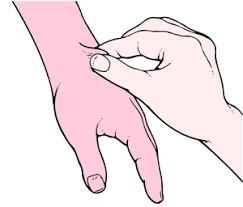A nurse is assessing the skin turgor of an older adult client. In which of the following areas should the nurse lift the skin?
Abdomen
Shoulder
Stomach
Neck
The Correct Answer is D
Choice A reason
Abdomen area is not appropriate: Assessing skin turgor on the abdomen is not commonly performed. The abdomen may not be the most accurate site for assessing skin turgor, especially in older adults, as it can be influenced by factors such as body fat distribution.
Choice B reason:
Shoulder are is not appropriate: The shoulder is not a typical site for assessing skin turgor. It is generally not used for this purpose, as it may not provide reliable results
Choice C reason:
Stomach is not the correct answer.: Assessing skin turgor on the stomach is also not commonly performed. The abdomen or stomach may not be the most accurate site for assessing skin turgor, especially in older adults.
Choice D reason
When assessing skin turgor in an older adult client, the nurse should lift the skin on the neck to evaluate its elasticity and hydration status. Skin turgor is a measure of skin's elasticity and is commonly used as an indicator of hydration in both adults and older adults.
To assess skin turgor, the nurse will gently pinch a small amount of skin on the back of the client's hand or the front of the chest (sternum). However, since the options listed do not include these areas, the closest alternative for an older adult would be the neck.

Nursing Test Bank
Naxlex Comprehensive Predictor Exams
Related Questions
Correct Answer is D
Explanation
Choice A reason:
"I try to respond to the baby quickly so she doesn't cry very long." This statement is incorrect because it indicates the parent's sensitivity to the baby's needs and responsiveness to the baby's cues, which are positive signs of appropriate caregiving.
Choice B reason:
"I have several friends who come by to help out with the baby." This statement is incorrect because having a support system in the form of friends who help with the baby is a positive factor that can reduce stress and promote a healthy postpartum period.
Choice C reason:
"I want to meet other parents to see if they are going through the same things." This statement is incorrect because seeking social support and connecting with other parents can be beneficial in reducing feelings of isolation and stress during the postpartum period.
Choice D reason:
"I think the baby should be sleeping through the night by now is the correct statement "I think the baby should be sleeping through the night by now," as a manifestation of increased risk for child abuse. This statement may indicate unrealistic expectations or frustration from the parent regarding the baby's sleep patterns.
It is common for newborns to wake frequently during the night for feeding and care, and their sleep patterns can vary significantly in the early weeks and months of life. Unrealistic expectations or frustration about the baby's sleep habits can contribute to increased stress for the parent, which might increase the risk of child abuse or neglect.
Correct Answer is D
Explanation
The correct answer is choice D. The client is oriented times three.
This means that the client knows who they are, where they are, and what time it is. This indicates a high level of consciousness and a normal Glasgow coma scale (GCS) rating of 15.
Choice A is wrong because the client withdraws from pain.
This means that the client reacts to a painful stimulus by pulling away from it. This indicates a lower level of consciousness and a GCS rating of 4 for motor response.
Choice B is wrong because the client is unable to obey commands.
This means that the client does not follow simple instructions such as moving a limb or opening their eyes. This indicates a lower level of consciousness and a GCS rating of 1 or 2 for motor response.
Choice C is wrong because the client opens eyes to sound.
This means that the client does not open their eyes spontaneously, but only when they hear a loud noise. This indicates a lower level of consciousness and a GCS rating of 3 for eye opening.
The Glasgow coma scale is a clinical tool used to assess the level of consciousness of a person after a brain injury.
It consists of three tests: eye opening, verbal response, and motor response.
Each test has a score range from 1 to 6, with higher scores indicating higher levels of consciousness. The total score ranges from 3 to 15, with lower scores indicating higher risk of death.
Whether you are a student looking to ace your exams or a practicing nurse seeking to enhance your expertise , our nursing education contents will empower you with the confidence and competence to make a difference in the lives of patients and become a respected leader in the healthcare field.
Visit Naxlex, invest in your future and unlock endless possibilities with our unparalleled nursing education contents today
Report Wrong Answer on the Current Question
Do you disagree with the answer? If yes, what is your expected answer? Explain.
Kindly be descriptive with the issue you are facing.
